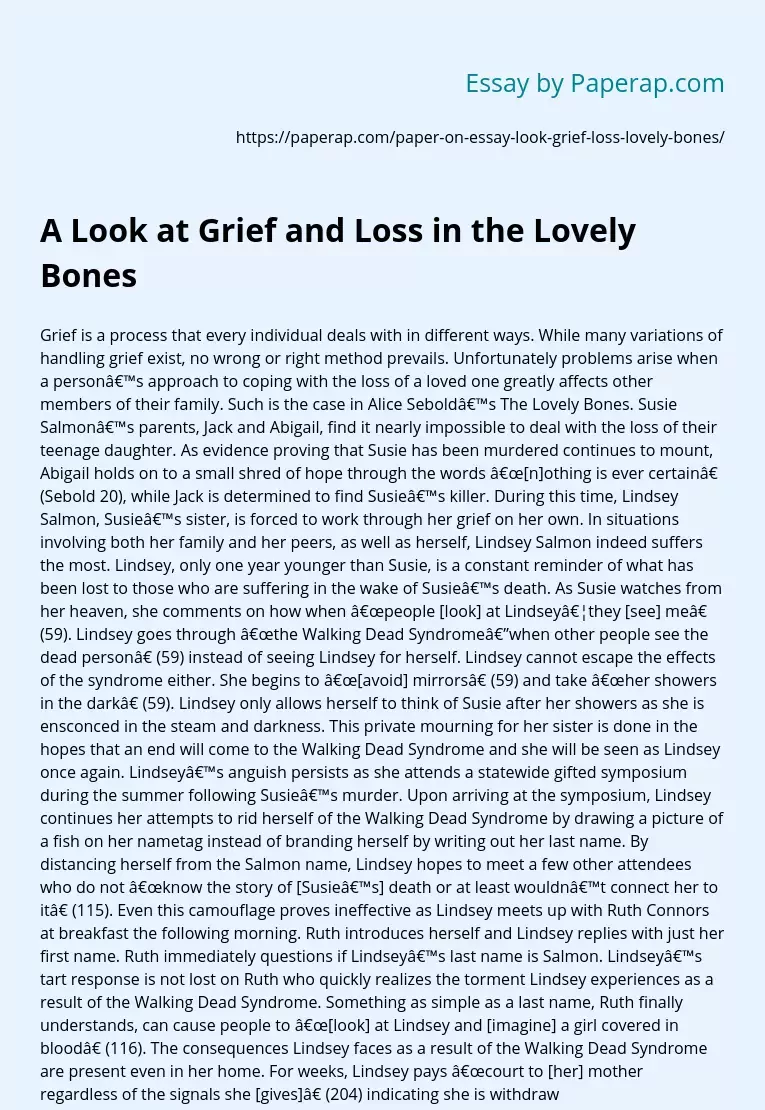A Look at Grief and Loss in the Lovely Bones
Grief is a process that every individual deals with in different ways. While many variations of handling grief exist, no wrong or right method prevails. Unfortunately problems arise when a person’s approach to coping with the loss of a loved one greatly affects other members of their family. Such is the case in Alice Sebold’s The Lovely Bones. Susie Salmon’s parents, Jack and Abigail, find it nearly impossible to deal with the loss of their teenage daughter.
As evidence proving that Susie has been murdered continues to mount, Abigail holds on to a small shred of hope through the words “[n]othing is ever certain” (Sebold 20), while Jack is determined to find Susie’s killer.
During this time, Lindsey Salmon, Susie’s sister, is forced to work through her grief on her own. In situations involving both her family and her peers, as well as herself, Lindsey Salmon indeed suffers the most. Lindsey, only one year younger than Susie, is a constant reminder of what has been lost to those who are suffering in the wake of Susie’s death.
As Susie watches from her heaven, she comments on how when “people [look] at Lindsey…they [see] me” (59). Lindsey goes through “the Walking Dead Syndrome—when other people see the dead person” (59) instead of seeing Lindsey for herself. Lindsey cannot escape the effects of the syndrome either. She begins to “[avoid] mirrors” (59) and take “her showers in the dark” (59). Lindsey only allows herself to think of Susie after her showers as she is ensconced in the steam and darkness.
This private mourning for her sister is done in the hopes that an end will come to the Walking Dead Syndrome and she will be seen as Lindsey once again.
Lindsey’s anguish persists as she attends a statewide gifted symposium during the summer following Susie’s murder. Upon arriving at the symposium, Lindsey continues her attempts to rid herself of the Walking Dead Syndrome by drawing a picture of a fish on her nametag instead of branding herself by writing out her last name. By distancing herself from the Salmon name, Lindsey hopes to meet a few other attendees who do not “know the story of [Susie’s] death or at least wouldn’t connect her to it” (115). Even this camouflage proves ineffective as Lindsey meets up with Ruth Connors at breakfast the following morning.
Ruth introduces herself and Lindsey replies with just her first name. Ruth immediately questions if Lindsey’s last name is Salmon. Lindsey’s tart response is not lost on Ruth who quickly realizes the torment Lindsey experiences as a result of the Walking Dead Syndrome. Something as simple as a last name, Ruth finally understands, can cause people to “[look] at Lindsey and [imagine] a girl covered in blood” (116). The consequences Lindsey faces as a result of the Walking Dead Syndrome are present even in her home.
For weeks, Lindsey pays “court to [her] mother regardless of the signals she [gives]” (204) indicating she is withdrawing even further from her family. Approximately a year after Susie’s death, Lindsey is sitting in the house with her mother, Abigail, when she notices an impromptu memorial service taking place in the cornfield where Susie died. Lindsey alerts Abigail to the service but Abigail refuses to attend. During this exchange, Lindsey intuits her mother will abandon their family and asks her mother if she will leave them.
Instead of telling the truth, Abigail promises not to leave. Just about a year later, Abigail departs for New Hampshire as she is unable to continue living in the suburban Pennsylvania town with her remaining teenage daughter; both constant painful reminders of Susie’s absence. Abigail’s desertion leaves Lindsey to fill in the roles of wife and mother. It won’t be long, though, before she will once again live her own life and be seen simply as Lindsey Soon after her college graduation, Lindsey begins to let go of Susie’s death and break away from the effects of the Walking Dead Syndrome.
Still watching from her heaven, Susie notices how “Lindsey [is] many things I would never become” (232) and realizes that Lindsey is beginning the process of becoming more than just Susie Salmon’s sister. Lindsey and Samuel, her boyfriend, decide to get married but there is one more hurdle that Lindsey must cross. News of her husband’s heart attack brings Abigail back to Pennsylvania where she is forced to confront the children she has abandoned.
Although their initial reunion is awkward, by the time Jack is discharged from the hospital both parents and children walk out as a family, “the four of them together” (314). Up above, Susie watches as her family arrives home and realizes that she has been waiting for them to come home “not to me anymore but to one another with me gone” (316). With any luck, a natural order usually accompanies death and loss. Parents are not meant to bury their children; siblings are not meant to say goodbye to their brothers or sisters while they are all still growing up.
Alice Sebold’s novel takes away that natural order and leaves a family in turmoil. While the journey of life after Susie’s death is not easy for any of the Salmons, Lindsey endures the greatest suffering, yet experiences the most complete process of dealing with the loss of Susie. Lindsey ultimately rids herself of the Walking Dead Syndrome. Susie herself sums it up best when she proclaims, “…my sister, my Lindsey, left me in her memories, where I was meant to be” (327).
Works Cited Sebold, Alice. The Lovely Bones. Boston: Little, Brown And Company, 2002.
A Look at Grief and Loss in the Lovely Bones. (2019, Jun 20). Retrieved from https://paperap.com/paper-on-essay-look-grief-loss-lovely-bones/

